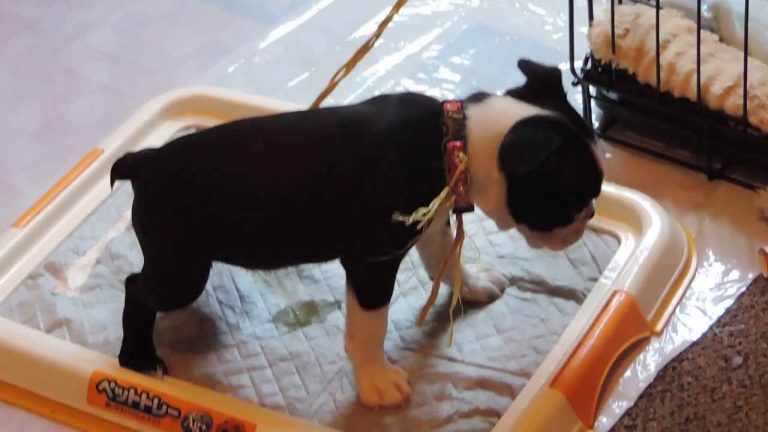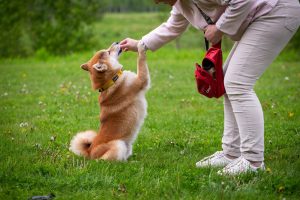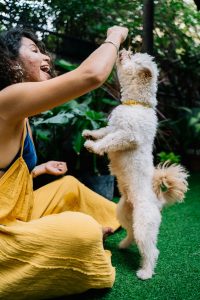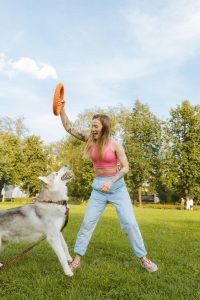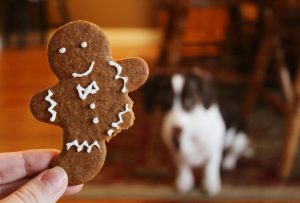Potty training a puppy requires good patience and endurance from the pet owner.
How to teach a puppy to go to the toilet outside?
Walking is not only a necessary activity for a dog, but also a great opportunity to teach the pet to go to the toilet outside the house. The speed of developing such a habit depends on the age of the animal. A six-month-old puppy can easily be taught to relieve itself outside in about a week. A younger dog will take longer to adapt, as a small puppy is not yet able to hold it for long.
It’s permissible to take the puppy outside no earlier than after all necessary vaccinations have been administered. Otherwise, the pet risks contracting diseases such as distemper, enteritis, or other dangerous health conditions. After completing vaccination and quarantine, start taking the puppy outside. Prepare for your pet in advance by purchasing a muzzle, harness, and collar for walking. Here is the scheme for training the puppy for walks:
- Take special dog treats with you when you go outside for encouragement. During the training period, it’s better to avoid giving these treats at home.
- Observe the puppy’s behavior. When it shows signs of needing to go to the toilet: circling, sniffing the floor, squatting, or trying to lift a leg — immediately take it outside.
- Praise and reward the pet every time it does its business outside.
- Clean up after the puppy to comply with the law and to avoid fines.
- Continue walking with the puppy even after it has done its business. After 10-15 minutes, the pet is likely to go to the toilet again. Besides, walks are necessary not only for natural needs but also for sufficient physical activity, enjoyment, and bonding with the owner.
The more responsibly and patiently you approach the process, the sooner you will achieve success. The first couple of days of potty training will require patience: taking the puppy out 4-5 times a day, or maybe even more often. But soon the number of walks can be reduced. The frequency of walks directly depends on the age of the animal:
- Until 6 months of age, the puppy should be walked 4-5 times a day for at least half an hour each. Don’t play with the puppy at home before the walk, so it can expend its energy in the fresh air.
- From six months of age, the number of walks can be reduced to 3 times a day.
- From one year of age, it’s sufficient to walk the dog twice a day. However, the walks should be active and last at least an hour each.
It’s permissible to walk the dog on a leash wherever there are no restrictions: in parks, squares, and on the street. Only unleash the pet in safe, traffic-protected areas. For example, on special dog playgrounds or in nature. Otherwise, it’s dangerous: the dog might get scared or distracted and run uncontrollably, risking getting hit by a car, or it might get into a fight with a large aggressive dog. Also, before going for a walk, teach the dog basic commands, such as ‘no!’, ‘come!’, and others. If the dog learns to obey these commands unconditionally, it can save its life in a critical situation.
After the puppy gets used to going to the toilet outside, it will start asking to go for a walk. You’ll recognize this by the following actions of the pet:
- Restless behavior;
- Whining and barking;
- Tense state – refusing to play or lie down;
- Constant ‘guarding’ near the front door.
If you notice such signals, don’t hesitate – get ready and go for a walk with the dog.
If you’ve adopted an adult dog from a shelter that has never lived in a house or apartment, it will take a week to 10 days to potty train. Train it like a puppy. It’s easier to train an adult animal than a baby, but be prepared that initially, you’ll need to be patient and sometimes clean up puddles. You still have to earn the dog’s trust, so don’t scold or punish it for mishaps. Simple rules will help speed up the training process:
- Stick to a single schedule, otherwise, it will be hard for the pet to learn to hold it. Initially, it’s better to do 3 walks a day, then two will be enough for an adult dog.
- Praise the dog when it relieves itself outside.
- Walk with the dog until it has done all its business.
How to Potty Train a Puppy in a House/Apartment?
Puppies up to 2 months old go to the toilet as many times as they eat (about 6 times a day), and less often afterwards. During this time, the owner will have to carefully watch the pet to ensure it doesn’t spoil anything. While the puppy cannot be taken outside, it’s necessary to train it to go to the toilet inside the house not just anywhere, but in a designated area. For this purpose, use a special puppy pad or a tray. The following knowledge about dog behavior will help you in training with the pad:
- Dogs never relieve themselves where they sleep – they always move aside. Therefore, after sleeping, immediately carry the puppy to the pad.
- Puppies tend to relieve themselves right after eating and activities.
Start training the puppy no later than 8 weeks of age. By three months, the pet should already be able to find the toilet on its own.
Trays for small dogs are similar to those for cats, but using cat trays is incorrect because they are uncomfortable for dogs. When choosing a tray for dogs, consider the following criteria:
- The size of the puppy – the tray should not be too cramped or too spacious;
- The sex of the puppy – for male dogs, there are special trays with a post, on which the animal will instinctively lift its leg;
- The height of the animal – the sides of the tray should not be too high so that it’s convenient for the pet to climb into it.
Place the toilet accessory where the pet often is. It’s better to choose a corridor, an entrance hall, or a bathroom for this, as it’s unhygienic to place the toilet in a bedroom or living room. If you’ve placed the dog’s tray in your bathroom, make sure that the door isn’t locked tightly so the animal can easily enter the room. Also, keep the dog’s tray clean: regularly change the filler and wash the container – the animal won’t go to the toilet in a dirty place.
When discouraging a dog from relieving itself indoors, under no circumstances should you scold or, even worse, hit it if it does go to the toilet in the wrong place. Standing next to the puddle, use your tone to show that you are upset. The dog will not want to upset its beloved owner again and will try not to repeat the behavior. Also, use simple techniques to discourage your pet from going to the toilet in inappropriate places:
- Use prohibitive commands. If you notice that your pet is getting ready to relieve itself inside the apartment, do not raise your voice, but command: ‘No!’ or ‘Don’t do that!’. Then put a collar on the dog and take it to the toilet outside or carry it to the pad if it is a puppy that does not go for walks yet.
- Create a feeding schedule based on the age of your pet. A very young puppy needs to go to the toilet right after eating. An older dog can hold it for a few hours. However, you should not feed the puppy after the evening walk – it will not be able to hold it until morning.
- Always praise the animal each time it goes to the toilet correctly, and give it a treat. If the dog continues to use the pad and does not ask to go outside, do not praise it so as not to slow down the training process.
- Do not be lazy to walk the dog if it asks to go out. If the animal cannot hold it and goes on the pad again, it will be a significant setback in training.
- Thoroughly clean and treat with a special pet store product the places where the dog went to the toilet in the apartment, so there is no remaining scent that might attract it.
- Remove carpets from the floor while training the dog to go to the toilet outside. Soft coverings remind the animal of grass, and it will happily relieve itself on them. If you have carpeting in your home that cannot be easily removed, do not allow the dog to walk on it until it is trained to go for walks.
Sometimes, a well-trained dog suddenly starts relieving itself inside the house. Do not rush to scold or punish the pet – first, it is important to understand the reasons. They may be as follows:
- The dog is ill;
- The dog is experiencing stress or anxiety due to the arrival of a child or another pet in the house;
- The dog is stressed due to a lack of attention from its owner.
- The first step is to take the animal to a veterinarian to rule out any illnesses. If there are no diseases, look for psychological reasons.
In conclusion, here are a few general useful tips:
- Start toilet training as soon as the dog enters your home. If you’ve adopted an adult animal, don’t rush to bring it inside immediately – take a walk nearby, let it look around, and mark places that it will later happily approach during walks.
- If potty training outside is taking too long, reconsider your actions. The reasons might be a lack of a feeding and walking schedule, not paying enough attention to the pet – you don’t notice when it asks to go outside, or you don’t praise it for correct behavior.
- Continue the walk until the dog has relieved itself both for a small and big need. If it seems that the walk is dragging on and the animal is not going to the toilet, it’s likely because there are too many distractions around. In this case, take the dog to a more secluded place and be sure to praise it when it does its business.
- During the process of potty training, pay special attention to your pet. Don’t forget to praise and reward for every achievement.

